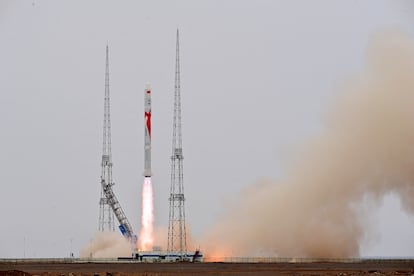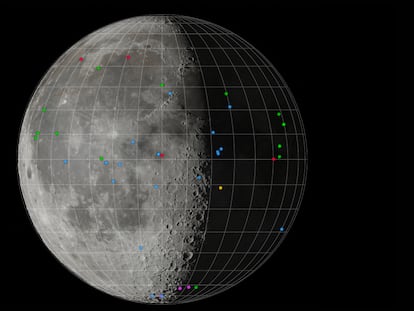China defeats Elon Musk in the race for the first methane-fueled space rocket
As SpaceX prepares a new launch of its Starship super rocket, an unknown Chinese company named LandSpace has beaten it to the punch and put an all-methane space shuttle into orbit

SpaceX is progressing toward a new Starship launch, following a static ignition test of its engines on Friday. This time, its Super Heavy booster’s 33 engines did ignite, although two of them shut down prematurely. Success in this on-the-ground technical maneuver is essential for the U.S. space company to try to put its super rocket into orbit again. Elon Musk has said on X (formerly Twitter) that such a flight will happen soon, despite the fact that federal authorization for the launch is still pending. Last week, new details emerged about the damage caused to the environment and wildlife by the previous attempt to launch Starship in the protected natural space around SpaceX’s base.
Super Heavy Booster 9 static fire successfully lit all 33 Raptor engines, with all but two running for the full duration. Congratulations to the SpaceX team on this exciting milestone! pic.twitter.com/1hzs768vHg
— SpaceX (@SpaceX) August 25, 2023
Elon Musk’s company claims to have made the necessary modifications around the pad to prevent its destruction and the tornado of debris that was blown off in the failed April 20 launch. If SpaceX receives clearance to fly and the changes made to the pad and rocket work, Starship will become the largest and most powerful rocket ever successfully launched. But now there is one record it can no longer achieve.
One of the most novel features of Starship, Elon Musk’s super rocket that exploded on its first flight attempt, is that its engines burn a type of methane fuel (known in the trade as methalox, a mixture of methane and liquid oxygen). The same can be said of the Blue Origin orbital rocket being developed by its competitor, Jeff Bezos. Some private Chinese companies have also decided to follow suit.
This summer a virtually unknown company called LandSpace announced that, following four of five unsuccessful attempts, it had successfully launched a rocket that’s powered by methane in all stages. With little fanfare ahead of time, on July 12 that space shuttle launched an inert payload into low-Earth orbit, a simple ballast to simulate the weight of a real satellite. Despite the English name, the company is Chinese, and the test was conducted in the JiuQuan area of the Gobi Desert.
This is the first time that an all-methane rocket has successfully completed an orbital flight: China made history with the Zhuque-2, a medium-lift launch vehicle named after the Vermilion Bird, one of the four mythological creatures in the Chinese zodiac. Memories of the April odyssey of Starship — SpaceX’s super-heavy-lift space shuttle, which ended with the destruction of the vehicle and part of its launch pad — are still fresh. Even more recently, a Blue Origin engine exploded during static testing. And late last year, China’s first launch of Zhuque-2 failed when the second-stage auxiliary engines failed to start after officially reaching space.
As a fuel, methane has some advantages over the kerosene burned by most rockets, including SpaceX’s Falcon 9. Methane is slightly more efficient, an advantage that increases by injecting it under pressure into the combustion chamber; it is cheap to produce; and it is easy to store in the rocket’s tanks. Methane must be kept at low temperatures, although not as low as the liquid hydrogen used in the highest-performance engines, such as those used in NASA’s Artemis SLS space shuttles bound for the Moon. In those rockets, helium must be injected into the tanks to propel the fuel to the pumps. Beside the fact that helium is expensive, the auxiliary circuit of tanks and pipes is another complication in the vehicle’s design. All of this affects the cost of each launch. On the other hand, methane rockets have their own pressurization system for when the fuel evaporates.
Methane’s advantages
Methane combustion generates less CO₂ and different pollutants than kerosene, a factor to consider when assessing each mission’s environmental impact. But its major advantage is that it leaves little residue when applied to reusable rockets. Just look at how the Falcon 9 lands with its lower fuselage blackened when its kerosene-burning braking engine is ignited for just a few minutes.
When SpaceX decided to use methane, Elon Musk gave a reason that bordered on science fiction: the atmosphere of Mars, its ultimate destination, is essentially CO₂. That will allow future expeditions to the red planet to synthesize the necessary methane for the return trip right there. That operation has not yet been tested, but the Perseverance robot has conducted an experiment to extract oxygen from the air on Mars at a rate of six grams per hour. In a real mission, the engines would need about seven tons of oxygen and about half that amount of methane to return to Earth.
From an operational standpoint, methane combustion cleanup is essential. Musk’s Mars plan calls for first launching a multitude of Starship super rockets, at a rate of two (or more) per week, to send the payload necessary to successfully undertake a Mars expedition into low-Earth orbit.
In fact, on those round trips to Earth orbit, the Starship boosters are not scheduled to land on concrete pads (as is the case with SpaceX’s current Falcon 9s) but will instead head to the very pedestal from which they took off. A pair of metal arms in the service tower should grab the booster in the final seconds of its descent and deposit it on the base. There, without having to move it, they will be able to clean its engines of the little residue left by the methane, check the rest of the systems, adapt a ship on the booster and leave the super rocket ready to take off again in a matter of hours. At any rate, that’s Elon Musk’s dream. But for now, the only methane rocket that has successfully flown is Chinese.
Sign up for our weekly newsletter to get more English-language news coverage from EL PAÍS USA Edition
Tu suscripción se está usando en otro dispositivo
¿Quieres añadir otro usuario a tu suscripción?
Si continúas leyendo en este dispositivo, no se podrá leer en el otro.
FlechaTu suscripción se está usando en otro dispositivo y solo puedes acceder a EL PAÍS desde un dispositivo a la vez.
Si quieres compartir tu cuenta, cambia tu suscripción a la modalidad Premium, así podrás añadir otro usuario. Cada uno accederá con su propia cuenta de email, lo que os permitirá personalizar vuestra experiencia en EL PAÍS.
¿Tienes una suscripción de empresa? Accede aquí para contratar más cuentas.
En el caso de no saber quién está usando tu cuenta, te recomendamos cambiar tu contraseña aquí.
Si decides continuar compartiendo tu cuenta, este mensaje se mostrará en tu dispositivo y en el de la otra persona que está usando tu cuenta de forma indefinida, afectando a tu experiencia de lectura. Puedes consultar aquí los términos y condiciones de la suscripción digital.
More information
Archived In
Últimas noticias
Most viewed
- Sinaloa Cartel war is taking its toll on Los Chapitos
- Oona Chaplin: ‘I told James Cameron that I was living in a treehouse and starting a permaculture project with a friend’
- Reinhard Genzel, Nobel laureate in physics: ‘One-minute videos will never give you the truth’
- Why the price of coffee has skyrocketed: from Brazilian plantations to specialty coffee houses
- Silver prices are going crazy: This is what’s fueling the rally










































